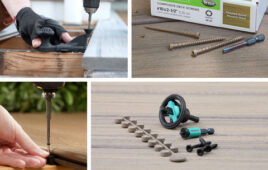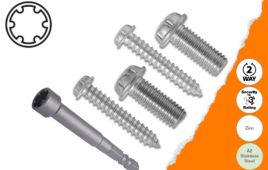Written by Jody Muelaner

A typical square-headed lag screw (left) and a countersunk-head metal screw (right).
Lag and metal screws are two types of self-tapping screws. Lag screws are primarily designed to be screwed into wood while metal screws are intended to be screwed into sheet metal.
A lag screw (also known as a coach screw) is a sturdy fastener, typically with an externally driven square or hex drive head. It features coarse threads, a tapered point, and is more heavy-duty than typical wood screws that are fitted with slotted or Pozidriv heads.
The name lag screw derives from their original use in securing barrel staves, also known as lags. This type of fastener requires a hole drilled at the same diameter as the shaft of the screw, and a gimlet point works to pull the screw into the hole, tapping its own thread.
A lag screw can also be used to fix to a masonry using a lag shield anchor or nylon anchor. Typical sizes available are from 1/4 to 3/4 inches in diameter, and between 1 and 16 inches in length.
Steel and stainless steel are the most common materials for lag screws. The steel ones are typically finished with hot-dip galvanizing or zinc plating. A construction screw may be used instead of a lag screw, which has a thinner shank, an internally driven head, and a fluted tip that negates the need for pre-drilling.
Construction screws have replaced lag screws in many applications.
A metal screw has a fully threaded shank, is self-tapping, and versatile. It has fine threads, which are sharp and hardened to allow thread forming and feature a tapping or thread-cutting point used in a pre-drilled hole or as a self-drilling point.
A metal screw has a countersunk or non-countersunk head with any of a wide variety of internal and external drive types. The size of a metal screw is usually shown with a series of three numbers representing the diameter number, thread count per inch, and length in inches.
One type of metal screw commonly used in roofing is a wood-to-metal self-drilling screw, designed for affixing soft materials, such as wood or cement board, to metal. Featuring a self-drilling point with wings further up the shaft, (after the initial hole has been made), the wings follow cutting a clearance hole in the soft material but being destroyed when entering the harder metal.
This screw provides a clearance drilling, tap drilling, thread tapping, and fixing solution in one operation.





Tell Us What You Think!